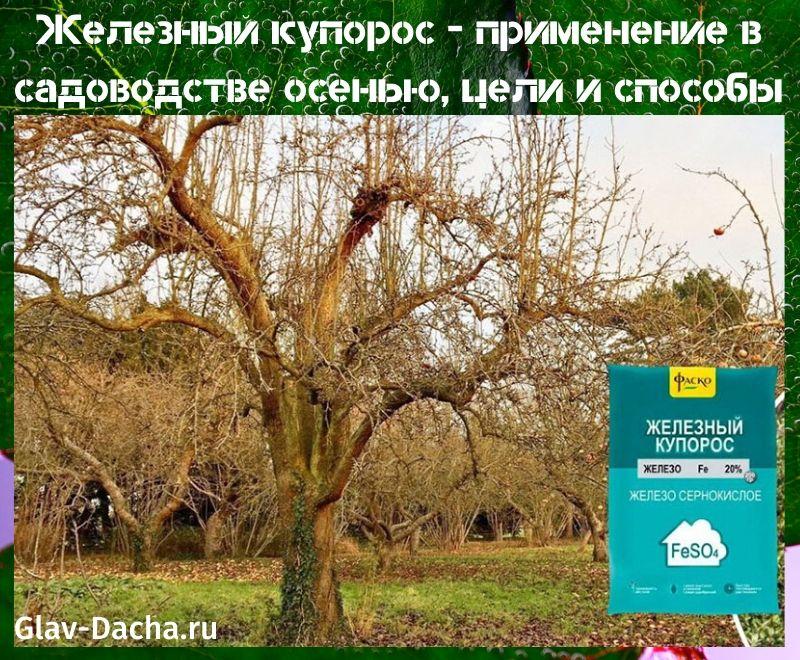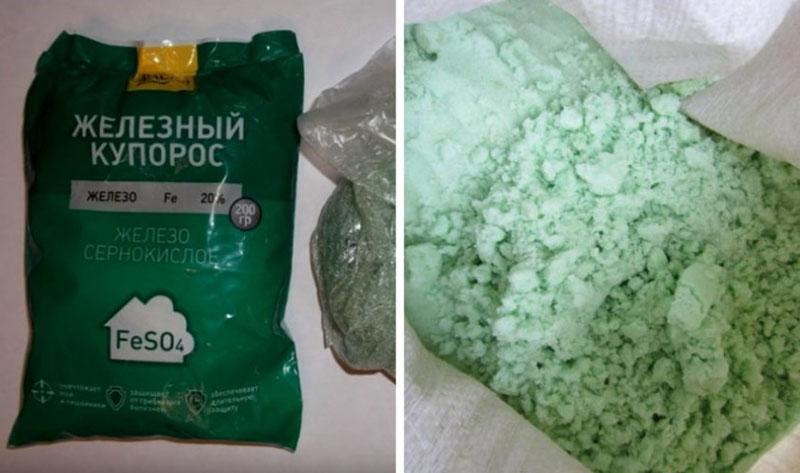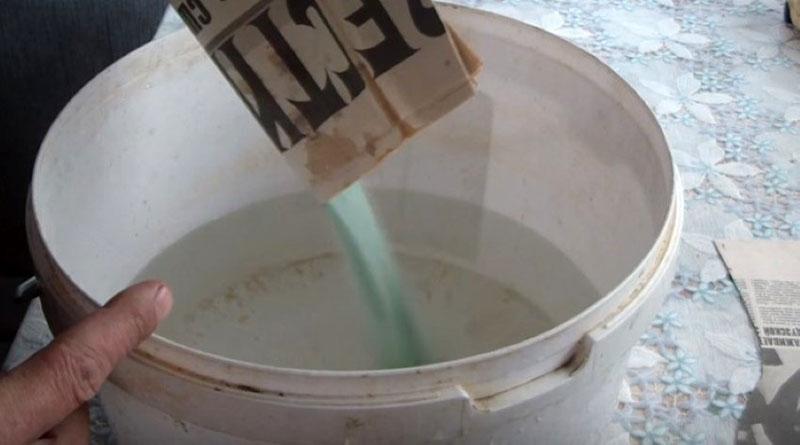Iron sulfate - use in gardening in the fall, goals and methods
 Every summer resident always has iron sulfate on the shelf with fertilizers. The use of this drug in gardening in the fall helps not only to heal crops from diseases, but also to prevent their appearance. And with iron deficiency, it quickly and effectively saves all plants from chlorosis. Of course, as with any chemicals, you can only get benefits with strict adherence to the rules.
Every summer resident always has iron sulfate on the shelf with fertilizers. The use of this drug in gardening in the fall helps not only to heal crops from diseases, but also to prevent their appearance. And with iron deficiency, it quickly and effectively saves all plants from chlorosis. Of course, as with any chemicals, you can only get benefits with strict adherence to the rules.
Improper processing and exceeding the permissible concentration of the solution can destroy the garden.
In order not to harm, it is important to know when, for what and how iron sulfate can be used.
Iron vitriol - use in gardening in the fall, the pros and cons of the drug

What is iron sulfate used for in the garden:
- With its help, garden trees and shrubs protect and treat many diseases.
- It can disinfect cuts after cutting, as well as cracks and hollows.
- Protects the trunks from fungi during autumn whitewashing.
- This drug is one of the most effective remedies in the fight against lichens and mosses.
- In some cases, it even helps to get rid of pests.
- Serves as an excellent fertilizer for iron deficiency in all horticultural and even flower crops. Warns and helps fight manifestations chlorosis.
The advantages of ferrous sulfate are its availability and low cost. The drug can always be found in garden stores. It has a wide range of applications, with a superficial effect. The solution does not penetrate into plants and does not accumulate in their parts. Ferrous sulfate has a low level of toxicity, but requires caution when used. As in working with any chemical preparations, care must be taken that it does not get on the mucous membrane.
Iron sulfate can often be found in hardware stores. It is used to treat walls against mold and mildew, as well as to disinfect and protect wood.
Of the disadvantages of ferrous sulfate, it is worth noting that it is easily washed off by rain. The effect occurs only after 2 hours, and the full effect - in a day. If there is precipitation during this period, re-treatment is required.
Iron vitriol - instructions for use
 The main condition for using ferrous sulfate is that there should be no leaves on the plants. A high concentration of iron leads to the fact that when it gets on the green part, it dies. Therefore, autumn with its leaf fall is the best time to process crops. But it is advisable to spray specimens infected with fungal spores directly on the foliage. It can contain pathogens that will burn up during a chemical reaction along with the leaves.
The main condition for using ferrous sulfate is that there should be no leaves on the plants. A high concentration of iron leads to the fact that when it gets on the green part, it dies. Therefore, autumn with its leaf fall is the best time to process crops. But it is advisable to spray specimens infected with fungal spores directly on the foliage. It can contain pathogens that will burn up during a chemical reaction along with the leaves.
You can still apply the drug in early spring, carrying out the treatment on the kidneys. But it is important to have time to do this before the leaves bloom. Although this remedy has one feature: after treatment with the kidneys, it delays their development. This can be exploited by spraying trees in anticipation of return frosts.
It is necessary to dilute the drug only in plastic or enamel containers, wearing gloves. No contact with iron buckets! The ready-made solution should be used immediately, it cannot be stored.
Iron vitriol - use in gardening in autumn for trees and shrubs
Ferrous sulfate solution can be used as a fertilizer or fungicide, for prophylactic or therapeutic purposes.
Application for fertilizing and chlorosis
 The drug will help both prevent and cure chlorosis. But for this it needs to be turned into a chelated form, which is most accessible to plants. You will need ordinary citric acid - 5 g per 2 liters of water. Separately, dilute 8 g of ferrous sulfate in the same amount of water (mandatory warm). Then mix both solutions, add another 1 liter and spray on the crops. Such processing is a good feeding of plants with iron.
The drug will help both prevent and cure chlorosis. But for this it needs to be turned into a chelated form, which is most accessible to plants. You will need ordinary citric acid - 5 g per 2 liters of water. Separately, dilute 8 g of ferrous sulfate in the same amount of water (mandatory warm). Then mix both solutions, add another 1 liter and spray on the crops. Such processing is a good feeding of plants with iron.
If cultures have already been affected, stronger concentration is needed. When signs of chlorosis (leaf clarification) appear, the plants should be treated by diluting 50 g of the drug in a bucket of water. Repeat the procedure every 5 days until the yellowing disappears. In this case, the soil can be sprayed too.
Treatment and prevention of diseases
 The concentration of the solution depends on the purpose of use. For the treatment of fruit trees and shrubs, a stronger solution is needed than for prevention. It also matters which crops are cultivated. Autumn spraying or treatment in early spring is mainly used.
The concentration of the solution depends on the purpose of use. For the treatment of fruit trees and shrubs, a stronger solution is needed than for prevention. It also matters which crops are cultivated. Autumn spraying or treatment in early spring is mainly used.
In case of urgent need, you can carry out the procedure during the growing season. For this, the recommended rates are necessarily reduced. The maximum concentration of the working solution for processing on a leaf of trees and shrubs should not exceed 0.5%. And for vegetable crops - no more than 0.25%.
| Diseases | Culture | Solution concentration |
| powdery mildew, gray and fruit rot, scab, black cancer, septoria, clasterosporium, anthracnose, alternaria, coccomycosis | stone fruits (peaches, plums, cherries, apricots) and berry bushes (currants, raspberries) | 3% (for 10 l of water 300 g of the preparation) |
| pome fruits (apple, pear, quince, grapes) | 4% (for 10 l of water 400 g of the preparation) | |
| lichens and mosses | stone fruits | 3 % |
| pome fruits | 5 % |
For very young plants, it is advisable to use a 1% solution. Iron sulfate will be of invaluable benefit for strawberry... Spraying in late autumn will relieve the berries of gray mold and powdery mildew. A 3% solution is suitable for processing (300 g of the drug per bucket of water). In this case, unused residues can be shed by beds, disinfecting the soil at the same time.
Whitewash
 Autumn whitewashing will not only protect against frost damage, but also destroy the fungi that live under the bark. To do this, dilute 250 g of ferrous sulfate in a bucket of water and whitewash the trunks and branches. There are ready-made whitewash compositions that contain iron vitriol.
Autumn whitewashing will not only protect against frost damage, but also destroy the fungi that live under the bark. To do this, dilute 250 g of ferrous sulfate in a bucket of water and whitewash the trunks and branches. There are ready-made whitewash compositions that contain iron vitriol.
Do not confuse ferrous sulfate with copper, the latter can be diluted with lime, but ferrous sulfate cannot. Instead, chalk is used to color the solution white.